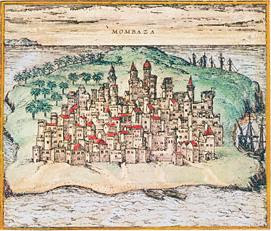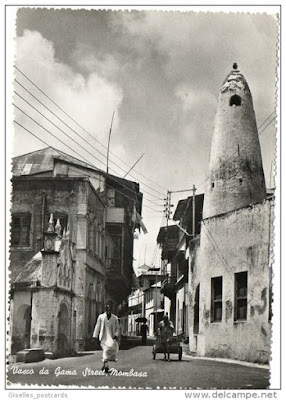Annamaria on Monday
The setting for my upcoming book—The Idol of Mombasa—has a fabulous exotic history: connected to the
Sultanates of Oman and of Zanzibar, trade with ancient China, Portuguese global
exploration, the Raj, and the search for the source of the Nile. The romance of this list gives me
gooseflesh. What a place! My series character—Vera Tolliver—describes
it as a locale where you “expect to see Aladdin walking along, carrying his
lamp.”
There has been a trading post on this island at least since
the early Middle Ages. Local oral
tradition says it was founded, sometime around 900 AD by a woman—Mwana Mkisi
and became the birthplace of the Swahili culture. The first people to settle there permanently
were traders and skilled craftsman. Links
were established with the Indian sub-continent and east as far as China. Trade was in gold, spices, and ivory. Once plantations, which relied on slave
labor, were in place, trade expanded to include millet, sesame, and cocoanuts.
 |
| Modern picture of the historic souk |
Mombasa’s harbor and its position on the Indian Ocean made
it a natural as an international city, the most important port on the East
African coast. Persian and Arab traders
were there early on. One Arab geographer
mentioned it in his documentation of 1151.
The first written account comes from a Moroccan traveler, writing in
1331. He stopped in overnight and wrote
in his journal, “a religious people, trustworthy and righteous. Their mosques are made of wood and expertly
built.”
As with many other
faraway places, Vasco Da Gama was the first European to show up in Mombasa—in
1498. He must have lusted after what he
saw, because he returned two years later and sacked the place. At the time that Vasco—that villain—arrived,
the city was ruled by the Sultan of Mombasa.
At which point there began a series of turnarounds for the
citizenry. Over the next four hundred, years hegemony over Mombasa went like this:
1528—Portuguese attack again and take over
1587—Zimba cannibals (!) put in a brief appearance
1589—Portuguese return and this time build Fort Jesus, which
still stands
1698—Sultan of Oman tosses out the Portuguese
1728—Portuguese make another cameo appearance
1729—Sultanate of Oman is back and endures for a century
1824—Britain makes its first sally
 |
| Fort Jesus, as it looks today |
 |
| Tunnel within the fort |
 |
| Ancient Portuguese grafitti |
Then, through a series of deaths, deals, and inheritances
within the Sultanate of Oman, by 1886, a ten-mile wide swath of the coast had
become the property of the Sultan of Zanzibar.
The Brits had been active in that
part of the world for a number of years, trying to get a permanent foothold. It was from Mombasa that they launched many
of their forays in search of the source of the Nile. British missionaries had moved into the
hinterlands with dual and interlinked purposes—to convert the pagans to
Christianity and as an important part of their effort to wipe out slavery worldwide. In 1886, the King’s empire builders made a
deal with the Sultan of Zanzibar, who gave them a concession in his territory
along the coast.
At that point Mombasa became the capital of the Protectorate
of British East Africa, into which they also included all the land going west
to Lake Victoria and north to the southern border of Uganda.
Just then, the Brits started to build a railroad from
Mombasa to Lake Victoria, a bold, fascinating project that I have described in
two posts before—here and here. Once the
railroad was completed, laborers imported from India for its construction often
stayed on and settled in Mombasa, giving the city yet another facet of its
fascination.
In 1906, since most of the European settlers were ensconced up
country, the Brits moved their administration to Nairobi, where the capital of
Kenya remains to this day.
Modern-day Mombasa stands as a pinnacle of historical
exoticism.
My characters walk around in the place as it was a hundred
years ago. Fortunately for me, photographic
evidence of what it looked like still exists.
Here are just a handful of the photos I have collected:
Lucky, lucky me, I also have eleven volumes of eye-witness
accounts—on my shelf in the New York Public Library.
































I always found Mombasa fascinating when I lived in Kenya, quite different from the inland of the country.
ReplyDeleteI'm greatly looking forward to the book! When does it come out?
It will launch at Bouchercon, Michael. Will you be there? I HOPE!
DeleteI am a little trepidatious about your reading it. You'll know if I got details wrong. Promise you'll tell me first if I did.
Given the depth of your research, if anything in the book is not as I remember it, then it's just another example of my poor memory!
DeleteUnfortunately I won't make Bouchercon this year. Our book has been delayed till next year. Sigh.
Sigh is right! I will have to come to Africa then. Hooray for that idea.
DeleteBe careful throwing around those F-words, AmA. After Jeff's fascinating comments yesterday, starting the blog right off with 'fabulous' is likely to set Jeff right off again.
ReplyDelete(Fabulous story, by the way! Can't wait for the second volume of your fabulous Tolliver series.)
Thank you, EvKa, for your kind words about the series.
ReplyDeleteRegarding Jeff: I am not sure he is talking to me after our debate on Saturday. :)
Our designating one another as Bro and Sis has turned out to TOO apt. We can argue about things we agree on. Let's see if he shows up here today and if he uses an f-word
e only f-word I have for you and your parevka is "flight" as B and I have been on planes since 11PM last night EDT and now it's 6:30pm. Which means I missed all the f-ing back and
ReplyDeleteOh my Bro, flying to where? Was it worth it. I HOPE!!!!!
DeleteFrom the way my typing came out on my comment, not sure the answer is yes. :) However, we just landed in NY on the way to Montana for a wedding, and then it's back on planes to Mykonos. Argggghh.
DeleteDoing the right thing. What a seductive and annoying concept. I hope this trip offers great pleasures. Montana is gorgeous, so there is hope in that regard. Safe travels.
ReplyDeleteI am so in awe of your research and courage! Thelma Straw in Manhattan
ReplyDeleteThank you so much, Thelma. You are a model of courage, if you ask me--striking out to an international professional life as you did. Huzzah for us women who refused to be kept in our place!
DeleteI'm a little late to the show, but here goes. I loved your post as with so many of your posts, I was right there. It was also fun to read about Mombasa since I never explored anything about it. "Out of Africa" opened this door for me, so now I just have to check out your books.
ReplyDeleteLil, My interest in Africa began with when I first read Out of Africa as a teenager. When I decided to set my series there, I picked the place where Karen Dinesen went to become the Baroness van Blixen in 1914. But I started the series in 1911. We will get to Karen, but for the first three books, we do meet Denys Finch Hatton, Berkeley Cole, Lord and Lady Delamere, as well as her baron--Blix. I had read that book quite a few times before I ever dreamed about setting a book there and then. The more I learn, the happier I am with my choice.
DeleteFascinating history, learned quite a bit. Oh, what we don't know is monumental.
ReplyDeleteAm fascinated about the journals, what they were written on, how they were kept. Where were they stored?
Am dismayed by the colonialism and the slave labor, but it was reality.
Kathy, a lot of my research materials are memoirs of people who were there at the time I write about. They often published in London at the time or shortly afterwards. I imagine that books about what it was like in those exotic places were popular with people on "home" ground in those days. And the GREAT NYPL has them all.
Delete